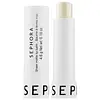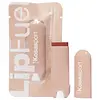What's inside
What's inside
 Key Ingredients
Key Ingredients

 Benefits
Benefits

 Concerns
Concerns

 Ingredients Side-by-side
Ingredients Side-by-side

Ricinus Communis Seed Oil
MaskingOctyldodecanol
EmollientButyrospermum Parkii Butter
Skin ConditioningSynthetic Beeswax
Emulsion StabilisingSynthetic Wax
AbrasiveSynthetic Fluorphlogopite
Helianthus Annuus Seed Wax
Skin ConditioningHydrogenated Castor Oil
EmollientCI 77491
Cosmetic ColorantCopernicia Cerifera Wax
CI 77492
Cosmetic ColorantCI 42090
Cosmetic ColorantIrvingia Gabonensis Kernel Butter
Skin ConditioningDisteardimonium Hectorite
StabilisingPolyhydroxystearic Acid
EmulsifyingTocopheryl Acetate
AntioxidantCaprylic/Capric Triglyceride
MaskingHydrogenated Coco-Glycerides
EmollientRosmarinus Officinalis Leaf Extract
AntimicrobialCitric Acid
BufferingRicinus Communis Seed Oil, Octyldodecanol, Butyrospermum Parkii Butter, Synthetic Beeswax, Synthetic Wax, Synthetic Fluorphlogopite, Helianthus Annuus Seed Wax, Hydrogenated Castor Oil, CI 77491, Copernicia Cerifera Wax, CI 77492, CI 42090, Irvingia Gabonensis Kernel Butter, Disteardimonium Hectorite, Polyhydroxystearic Acid, Tocopheryl Acetate, Caprylic/Capric Triglyceride, Hydrogenated Coco-Glycerides, Rosmarinus Officinalis Leaf Extract, Citric Acid
Ricinus Communis Seed Oil
MaskingCaprylic/Capric Triglyceride
MaskingEuphorbia Cerifera Cera
AstringentBis-Diglyceryl Polyacyladipate-2
EmollientMica
Cosmetic ColorantSilica
AbrasiveOctyldodecanol
EmollientLanolin Oil
EmollientJojoba Esters
EmollientPentaerythrityl Tetraethylhexanoate
EmollientHelianthus Annuus Seed Cera
EmollientBeeswax
Emulsion StabilisingCopernicia Cerifera Wax
Camellia Oleifera Seed Oil
Skin ConditioningTheobroma Cacao Seed Butter
EmollientVitis Vinifera Seed Oil
EmollientAcacia Decurrens Flower Cera
EmollientButyrospermum Parkii Butter
Skin ConditioningCaprylyl Glycol
EmollientCarthamus Tinctorius Seed Oil
MaskingEthylhexyl Palmitate
EmollientEthylhexylglycerin
Skin ConditioningGlucomannan
Skin ConditioningHelianthus Annuus Extract
EmollientMangifera Indica Seed Butter
Skin ConditioningMentha Arvensis Leaf Oil
MaskingOryza Sativa Bran Extract
Skin ConditioningPersea Gratissima Oil
Skin ConditioningPolyglycerin-3
HumectantRosa Canina Fruit Oil
EmollientRosmarinus Officinalis Leaf Extract
AntimicrobialSimmondsia Chinensis Seed Oil
EmollientSodium Hyaluronate
HumectantTocopherol
AntioxidantTocopheryl Acetate
AntioxidantTrihydroxystearin
Skin ConditioningLimonene
PerfumingCI 77891
Cosmetic ColorantCI 15850
Cosmetic ColorantCI 77491
Cosmetic ColorantCI 77492
Cosmetic ColorantCI 77499
Cosmetic ColorantCI 73360
Cosmetic ColorantRicinus Communis Seed Oil, Caprylic/Capric Triglyceride, Euphorbia Cerifera Cera, Bis-Diglyceryl Polyacyladipate-2, Mica, Silica, Octyldodecanol, Lanolin Oil, Jojoba Esters, Pentaerythrityl Tetraethylhexanoate, Helianthus Annuus Seed Cera, Beeswax, Copernicia Cerifera Wax, Camellia Oleifera Seed Oil, Theobroma Cacao Seed Butter, Vitis Vinifera Seed Oil, Acacia Decurrens Flower Cera, Butyrospermum Parkii Butter, Caprylyl Glycol, Carthamus Tinctorius Seed Oil, Ethylhexyl Palmitate, Ethylhexylglycerin, Glucomannan, Helianthus Annuus Extract, Mangifera Indica Seed Butter, Mentha Arvensis Leaf Oil, Oryza Sativa Bran Extract, Persea Gratissima Oil, Polyglycerin-3, Rosa Canina Fruit Oil, Rosmarinus Officinalis Leaf Extract, Simmondsia Chinensis Seed Oil, Sodium Hyaluronate, Tocopherol, Tocopheryl Acetate, Trihydroxystearin, Limonene, CI 77891, CI 15850, CI 77491, CI 77492, CI 77499, CI 73360
 Reviews
Reviews

Ingredients Explained
These ingredients are found in both products.
Ingredients higher up in an ingredient list are typically present in a larger amount.
This ingredient is also known as shea butter. It is an effective skin hydrator and emollient.
Emollients help soothe and soften your skin. It does this by creating a protective film on your skin. This barrier helps trap moisture and keeps your skin hydrated. Emollients may be effective at treating dry or itchy skin.
Shea butter is rich in antioxidants. Antioxidants help fight free-radicals, or molecules that may harm the body. It is also full of fatty acids including stearic acid and linoleic acid. These acids help replenish the skin and keep skin moisturized.
While Shea Butter has an SPF rating of about 3-4, it is not a sunscreen replacement.
Shea butter may not be fungal acne safe. We recommend speaking with a professional if you have any concerns.
Learn more about Butyrospermum Parkii ButterThis ingredient is an emollient, solvent, and texture enhancer. It is considered a skin-softener by helping the skin prevent moisture loss.
It helps thicken a product's formula and makes it easier to spread by dissolving clumping compounds.
Caprylic Triglyceride is made by combining glycerin with coconut oil, forming a clear liquid.
While there is an assumption Caprylic Triglyceride can clog pores due to it being derived from coconut oil, there is no research supporting this.
Learn more about Caprylic/Capric TriglycerideCi 77491 is also hydrated iron III oxide. It's sole purpose is to give a red/pink hue to products.
Iron III oxides are classified as inorganic chemicals for coloring.
Synthetically created Ci 77491 is considered safer than those naturally found. This is because the synthetically created version may contain less impurities. Iron oxides are generally non-toxic and non-allergenic.
Learn more about CI 77491Ci 77492 is also hydrated iron III oxide. It's sole purpose is to give a yellow hue to products.
Iron III oxides are classified as inorganic chemicals for coloring.
Synthetically created Ci 77492 is considered safer than those naturally found. This is because the synthetically created version may contain less impurities. Iron oxides are generally non-toxic and non-allergenic.
Learn more about CI 77492Copernicia Cerifera Wax comes from a palm tree native to Brazil; another name for this ingredient is Carnauba Wax.
This ingredient is used to thicken texture and also leaves behind a film when applied.
Fun fact: This wax has the highest melting point of all natural waxes and low solubility.
Learn more about Copernicia Cerifera WaxOctyldodecanol is a fatty alcohol. It is primarily used to enhance the texture of products.
As an emulsifier, Octyldodecanol helps prevent the oils and waters from separating. It also prevents ingredients from creating foam when shaken.
Octyldodecanol is created by reducing fatty acid to an alcohol.
Due to its high molecular weight, it does not get absorbed into the skin.
Learn more about OctyldodecanolRicinus Communis Seed Oil is the INCI name for castor oil.
Castor Oil helps moisturize the skin. It is rich in a fatty acid called ricinoleic acid. This fatty acid helps prevent moisture loss on the skin. This helps keep your skin soft and hydrated. Ricinoleic acid also has anti-inflammatory and pain reducing properties.
Besides hydrating the skin, castor oil is also used to hydrate hair. By keeping the hair shaft moisturized, breakage is decreased. More studies are needed to show castor oil's effective on stimulating hair growth.
Castor oil is created by cold-pressing castor seeds and then purifying the oil with heat. It was used in Ancient Egypt as fuel in lamps and to help treat eye irritation.
The term 'fragrance' is not regulated in many countries. In many cases, it is up to the brand to define this term. For instance, many brands choose to label themselves as "fragrance-free" because they are not using synthetic fragrances. However, their products may still contain ingredients such as essential oils that are considered a fragrance.
Learn more about Ricinus Communis Seed OilRosmarinus Officinalis Leaf Extract comes from rosemary. Rosemary is native to the Mediterranean.
While Rosmarinus Officinalis Leaf Oil can be volatile due to its fragrant properties, the fragrance components are usually removed in the leaf extract.
Rosemary Leaf Extract contains many antioxidants such as rosmarinic acid and caffeic acid. Rosemarinic acid, a compound found in rosemary leaf, has been found to help soothe skin conditions such as eczema and acne.
Learn more about Rosmarinus Officinalis Leaf ExtractTocopheryl Acetate is AKA Vitamin E. It is an antioxidant and protects your skin from free radicals. Free radicals damage the skin by breaking down collagen.
One study found using Tocopheryl Acetate with Vitamin C decreased the number of sunburned cells.
Tocopheryl Acetate is commonly found in both skincare and dietary supplements.
Learn more about Tocopheryl Acetate